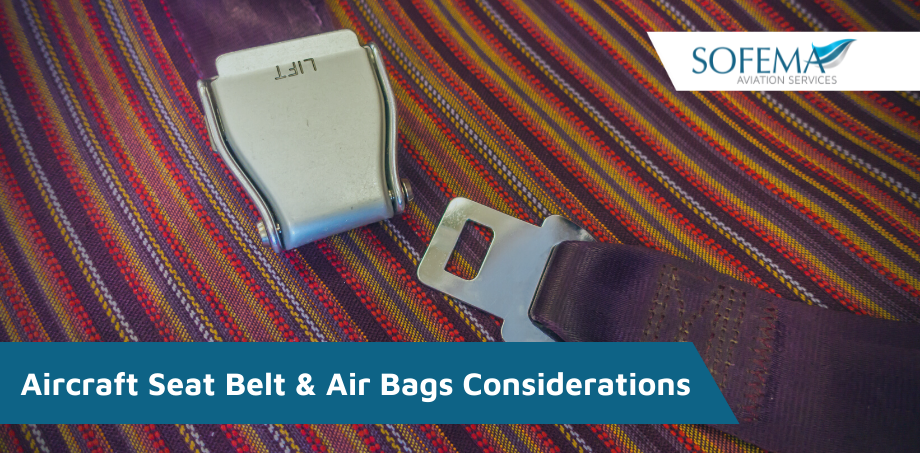Sofema Aviation Services (SAS) www.sassofia.com takes a background look at the certification of Aircraft Seat Belt Systems.
Introduction
- Aircraft manufactured prior to 2009 were required to have seats and belts that could withstand a 9g static load.
- Post 2009 seats and seat belts are certified to withstand loads up to 16g.
o Updated testing methodology.
Head Injury Criterion – HIC uses the time and acceleration rate of a human head prior to impacting an object (like a seat back) to generate an injury risk value. (25.562 Emergency landing dynamic conditions require airline passenger seats have an accident HIC value under 1000.)
Note – HIC values above 1000 are considered life-threatening.
Seat backs absorb the energy of an impact (Resting your head against the seat in front of you reduces your HIC value) – The distance between rows typically keeps a passenger’s head from accelerating enough to generate HIC values above 1000.
When rows are spaced further apart, we see higher HIC values because the passenger’s head has more time to accelerate before the seat back impact.
Conventional Buckle – Features
- Simple design & operation
- Resists unlatching during impact
- Easy for rescuers to release in an evacuation.
- Self-Clearing Mechanism: Debris is released during insertion into the buckle.
First & Business HIC challenge
- Challenge regarding the requirement to meet the 1000 HIC requirement:
FAA approved solution. An airbag integrated into a passenger lap belt. (the Seatbelt Airbag meets the 16g Head Injury Criterion (HIC) In Accordance With CS/25.562.
An option to satisfy the HIC regulation requirements involves a 3 point shoulder belt . The document concerning passenger seat belt standards is TSO-C22G.
Note Concerning Load Capability (16g Compliant) – The required strength of a seat belt can be calculated by taking the average passenger weight of 170 pounds and multiplying by 16 G’s. (170 lbs x 16 G’s = 2710 lbs – usually rated at 3000 Ibs)
Seat Belt Identification – labels are made of fabric or metal & list (Compliant with Part 21 Subpart Q)
- Name and address of the manufacturer
- Model name or part number of the seat belt
- Serial number or date of manufacture
- State Safety Agency Approval/Authorization code
Flight Attendant Seat Belts 4 point & Pilot 5 Point
Regulations require that flight attendant seats have over-shoulder straps to protect the upper torso. A single point, quick release buckle is also required. (Pilots have a fifth strap known as a “crotch” or “submarine” strap that comes up between the legs and attaches to the quick release.)
The four-point harness is designed so flight attendants can quickly get out of their seats. This helps them accomplish their primary job of helping passengers evacuate the aircraft in an emergency.
The five-point harness allows pilots to remain in control of the aircraft during all aircraft configurations.
Next Steps
Follow this link to our Library to find & Download related documents for Free.
Sofema Aviation Services (SAS) provides Consultancy, Classroom, Webinar and Online Training including a 5-day EASA CS 25 Compliant Cabin Certification & Mods Training Program.
For additional details, please see our websites www.sassofia.com and www.sofemaonline.com or email team@sassofia.com
Tags:
Aircraft, aviation, Aviation Training, EASA, EASA compliant, aviation courses, EASA Certification, Aircraft Seat Belt, Seat Belt, Air Bags, Head Injury Criterion, Head Injury Criterion (HIC)





